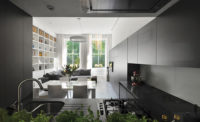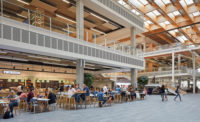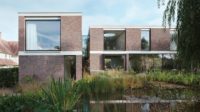After 30 years in their farmhouse outside Bolzano, in northern Italy, and with their children grown up, Josef Ebner and Angela Sabine Staffler found themselves with surplus space and decided to convert part of the property for rent. So they created two apartments in their existing house (where they still live) and a pair of mini-residences in a new building, catering to tourists who flock to the mountains of South Tyrol. Though the couple had no particular intention that architecture should itself be a draw, recalls Ebner, they wanted 'something special' and called in architect Peter Pichler, who had recently established his own office in Bolzano after working for Zaha Hadid.
Permission from the local authorities to develop the site imposed a strict limit on the interior volume of the new building'sufficient for two dwellings, each 430 square feet, with a ceiling height of 9 feet'and required that it should sit just yards from the farmhouse. The location allowed the new houses to face a private access road and apple orchards beyond, but meant they would back onto the family's pool and block the view from the farmhouse's garden. Consequently, the clients' only brief was that the building should be 'there but not there'; the design should make a positive contribution to the landscape, while somehow receding from view.
Pichler's response was simple but effective. The wood-framed houses, which share a party wall, are cantilevered off a poured-in-place concrete basement, so they appear to float 6 inches off the ground, and are subtly distinguished by slight offsets in plan and section. By cladding the garden facade in six identical mirrored-glass panels, Pichler lent the boxy form an abstract character reminiscent of a Donald Judd sculpture. The flatness of the surface is given life and depth by its surroundings. In the daytime, the facade compensates for the lost mountain vista to the southeast by reflecting hills to the northwest. At dusk, the building becomes more enigmatic still. As the mirrored glass gathers the last of the setting sun, it is also backlit by soft rectangles of electric light emanating from concealed windows.
Guests arriving at the front encounter a building with a livelier, more open character than the laconic back would suggest. Pichler brushes off any suggestion of figurative references, but the structure does call to mind a pair of eyes looking out at the landscape. The fully glazed front reveals all-white interiors, in contrast to the black aluminium skin on the two sides. Projecting decks and canopy roofs make upper and lower eyelids whose gentle curves are picked up and amplified in tapering horizontal glazing on the side walls.
Along with the spline curves of the undulating roofline, the north and south side elevations trace a gradient from the orthogonal regularity of the back facade to the lighter, looser front and the landscape beyond, says Pichler. Parametric software used to generate construction information saved time and money even on a building of this size, reports the architect, and allowed the close collaboration with fabricators necessary to achieve the desired precision.
The level of care evident in the fine tolerances and complexity of material junctions imbues the apparently simple interiors with a quiet finesse. Tracks for tight-pleated drapes and sliding doors to the bedroom, closet, and bathroom are discreetly buried in the drywall ceiling, while the frame of the front facade's glass wall is set flush with a poured resin floor that extends out onto the deck. The larger moves express the same sense of precision: cantilevering the roof beams from solid timber panels in the side walls means that no columns interrupt the glazed corners. And in each compact bedroom, Pichler exploited the 3-foot depth of the roof to carve out a skylight above the bed, increasing the sense of space without eating into the precious volume allowance.
At 110 square feet, the bedroom is smaller than standards would ordinarily allow but was permitted here, as the house is considered one single room. The sliding wood-veneered partition allows inhabitants to sleep cocooned behind it if they choose, or wake up to the play of light and shadow across the faces and fissures of the mountains beyond the orchards.
It is in this prospect that the true purpose of the twin houses becomes clear. Stringent environmental regulations and a contemporary concern for comfort demand a plethora of mechanical and electrical equipment and a highly insulated envelope. But with a great glass sliding door opening each unit to the breeze, the houses offer their temporary residents a taste of something like Thoreau's rougher-hewn Walden cabin, whose simplicity and intimate scale fostered his sense of connection to the environment. In their outward appearance, the Mirror Houses do little to blend in with their surroundings'the opposite, in fact'but, from the inside, the building seems almost to disappear, registering only as a frame for the view. 'There but not there,' one might say.
Size: 860 square feet
Construction Cost: withheld
Completion Date: November 2014
Architect:
Peter Pichler Architecture
VIA EDISON 15
39100 Bolzano
Italy
PeopleClient: Angela Sabine Staffler Owner: Angela Sabine Staffler Architect: Personnel in architect's firm who should receive special credit: Engineers: SP3 ENGINEERING, Ing. Rienzner Consultant(s): Other: MEP: Ing. Mayr Hansi Photographer(s): Oskar Da Riz |
ProductsStructural system Exterior cladding Other cladding unique to this project: MIRROR GLASS 5.5 x 2m Roofing Windows Doors Wood doors: carpenter, local nut wood Sliding doors: aluminum, SKYFRAME Furnishings Tables:PLANK, Konstantin Grcic Lighting |












Post a comment to this article
Report Abusive Comment